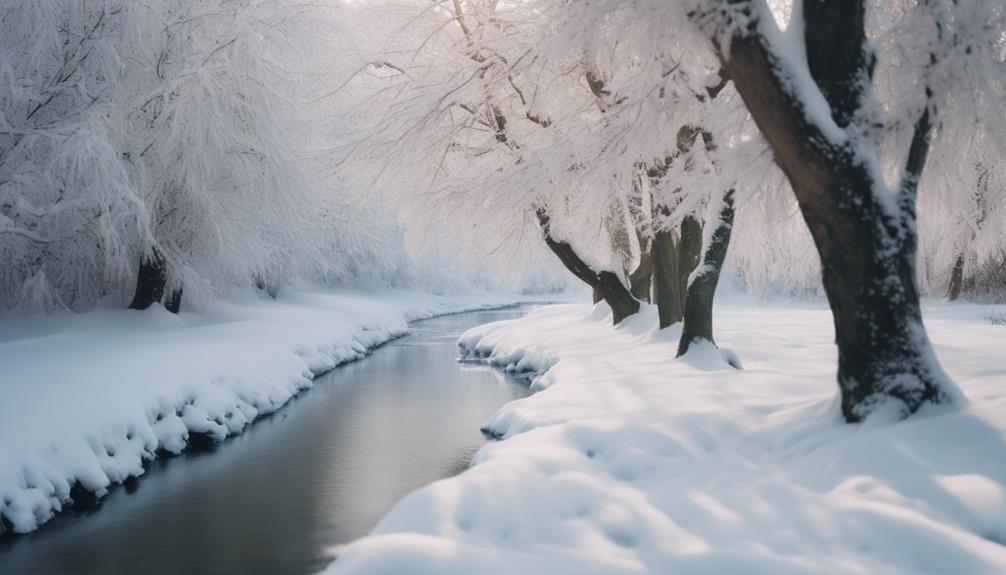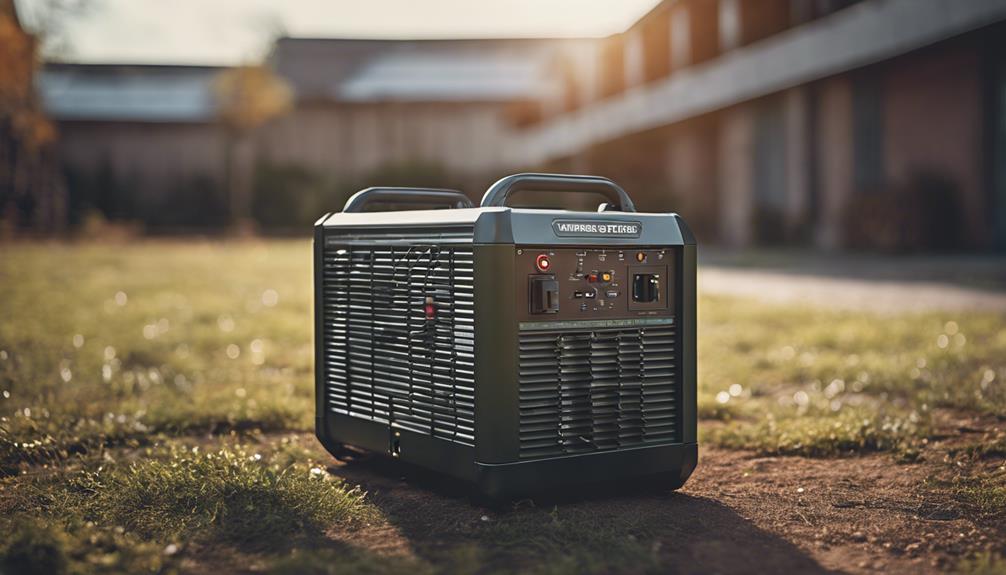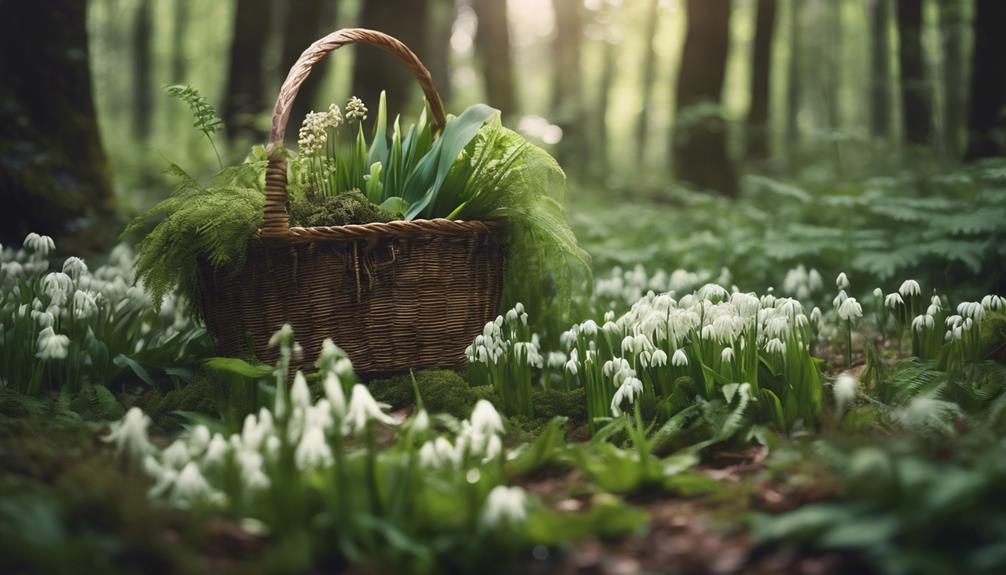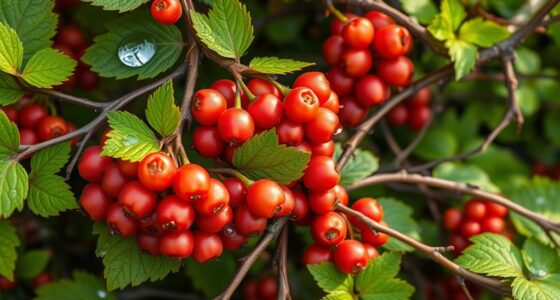You can forage in the winter, and with the right gear, knowledge, and precautions, you can uncover a wealth of edible and medicinal plants that thrive during this time of year. Warm clothing, pruners, and a gathering bag are essential gear. Identify plants by their needle-like leaves, berries, and bark patterns, and learn about medicinal plants like echinacea and elderberry. Be cautious when foraging in snowy conditions, and prioritize safety by notifying someone of your whereabouts and properly identifying plants. By following these winter foraging tips, you'll be well on your way to discovering the wonders of winter foraging – and there's more to explore.
Key Takeaways
- Yes, you can forage in the winter, focusing on evergreen plants, roots, and berries that thrive in cold weather.
- Adapt your gear for snowy conditions, wear warm clothing, and use snowshoes or crampons to access winter foraging spots.
- Identify winter-hardy plants like pine needles, juniper berries, and wintergreen berries, and use field guides or workshops for proper identification.
- Preserve your winter finds by drying, freezing, or canning to enjoy year-round, and experiment with winter foraging recipes.
- Prioritize safety by dressing warmly, notifying someone of your whereabouts, and being aware of wildlife and ice safety near frozen bodies of water.
Essential Winter Foraging Gear
When you head out into the cold, you'll want to make sure you're equipped with the right gear to stay warm, comfortable, and efficient while foraging for winter goodies. Having the essential winter foraging gear can make all the difference in your foraging experience.
You'll need a warm coat to keep you cozy, a hat to prevent heat loss, and a solid pair of boots to keep your feet dry and warm. Fingerless gloves will allow you to grasp and handle plants while keeping your hands warm. A barebones gathering bag will help you carry your finds, and barebones pruners will come in handy for harvesting.
Investing in quality winter foraging gear is essential for a successful and enjoyable experience. The right gear ensures you stay protected from the elements and can focus on exploring and harvesting during your winter foraging adventures.
With the right equipment, you'll be able to forage in winter with confidence, gathering winter goodies efficiently and effectively. By prioritizing your comfort and safety, you'll be able to make the most of your winter foraging excursions and enjoy the thrill of foraging in winter.
Identifying Edible Winter Plants

Recognizing edible winter plants requires you to develop a keen eye for detail, as the subtle characteristics of these plants can be the difference between a delicious find and a poisonous mistake. When foraging in the winter, look for plants with distinct features like needle-like leaves, berries, or unique bark patterns. Pine needles, for instance, can be used to make a warm and soothing tea, while juniper berries can be used to add flavor to jams and preserves.
Wintergreen berries, on the other hand, can be used to add a burst of flavor to your dishes. To improve your identification skills, consider using field guides, online resources, or attending foraging workshops. Understanding the key features and properties of winter plants will help you confidently forage for them in the colder months.
Medicinal Plants for Cold Season

As you venture out to forage for medicinal plants during the cold season, you'll want to focus on finding those that can help alleviate symptoms of cold and flu, as well as soothe dry winter skin.
Fortunately, nature provides an array of remedies that can help you feel better and look healthier. From immune-boosting plants to natural pain relievers, you'll discover a range of medicinal plants that can be used to create effective cold and flu remedies and winter skin soothers.
Cold and Flu Remedies
To combat the misery of cold and flu season, turn to medicinal plants like echinacea, elderberry, and pine needles, which have been used for centuries to alleviate symptoms and boost your immune system. As you forage through winter, you can find these natural remedies to help you feel better.
| Plant | Benefits |
|---|---|
| Echinacea | Boosts immune system, reduces cold symptoms |
| Elderberry | Antiviral properties, shortens cold and flu duration |
| Pine Needles | Rich in vitamin C, alleviates cold symptoms |
When winter foraging, you can use these plants to create natural remedies. Echinacea is known for its immune-boosting properties, while elderberry has antiviral properties that can help shorten the duration of colds and flu. Pine needles, rich in vitamin C, can be brewed into a tea to alleviate cold symptoms. By incorporating these medicinal plants into your winter foraging routine, you can create natural remedies to help you feel better during cold and flu season.
Winter Skin Soothers
When the cold winter air starts to dry out your skin, you can turn to medicinal plants like yarrow, pine needles, echinacea, elderberry, and willow bark to find soothing relief. These winter skin soothers can provide natural remedies for your dry, itchy skin.
Yarrow, with its wound-healing properties and anti-inflammatory effects, can calm irritated skin. Pine needles, rich in vitamin C and antioxidants, can help rejuvenate and protect your skin from the harsh winter elements. Elderberry's antiviral properties can also benefit your skin health during the cold season.
Meanwhile, willow bark is a natural source of salicylic acid, known for its anti-inflammatory and exfoliating properties. By incorporating these medicinal plants into your skincare routine, you can say goodbye to dry, flaky skin and hello to a radiant glow.
Winter Fungi Foraging Tips

When you delve into winter fungi foraging, it's crucial to focus on identifying edible species, understanding their habitats, and growth patterns, and learning how to preserve your finds.
You'll want to familiarize yourself with the characteristics of species like Chaga, Turkey Tail, and Lion's Mane, which thrive during mid-winter warm-ups.
Identify Edible Species
What winter fungi species should you search for during the cold winter months to reap their medicinal and culinary benefits? As you venture out into the winter landscape, keep an eye out for Chaga, Turkey Tail, Lion's Mane, Reishi, and Birch Polypore. These species are prized for their unique properties and flavors.
To guarantee a successful foraging experience, it's vital to learn about the distinctive features of each winter fungi species. Consult a reliable field guide and practice proper identification techniques to avoid toxic lookalikes.
Here's a brief overview of some popular winter fungi species:
| Species | Habitat | Uses |
|---|---|---|
| Chaga | Birch trees | Tea, tincture, culinary |
| Turkey Tail | Deciduous forests | Tea, soup, medicinal |
| Lion's Mane | deciduous and coniferous forests | Culinary, medicinal |
| Reishi | deciduous and coniferous forests | Tea, tincture, medicinal |
Remember to explore recipes and uses for winter fungi, and always prioritize safe foraging practices. By doing so, you'll access the full potential of these incredible winter fungi species.
Fungi Habitat and Growth
You'll want to focus on deciduous and coniferous forests, as well as birch trees, when searching for prized winter fungi species like Chaga, Turkey Tail, Lion's Mane, and Reishi.
Birch trees, particularly those in the north, are known for hosting Chaga growth, making them a prime target for winter foraging.
When foraging for winter fungi, keep an eye out for species that thrive during mid-winter warm-ups, such as Chaga, Turkey Tail, and Oyster mushrooms. You might also stumble upon Yellowfoot Chantrelles, which appear during the winter season.
As you explore these forests, pay attention to the birch bark, as it can provide a habitat for certain species of winter fungi.
Remember to also look for medicinal and edible lichens like Usnea and Reindeer moss, which can be foraged during the winter months.
Preserve Winter Fungi Finds
By mastering the art of preserving winter fungi finds, you can enjoy your prized discoveries throughout the year, from soups to teas, without worrying about spoilage or loss of flavor.
To preserve winter fungi finds, you can use proper drying or freezing methods. For instance, you can dry mushrooms like Usnea and Reindeer moss for medicinal or culinary purposes to extend their shelf life. When freezing, mushrooms like Oyster mushrooms or Chaga Fungus can help preserve their texture and flavor for future use.
It's essential to store your winter fungi finds in airtight containers or vacuum-sealed bags to maintain freshness and prevent moisture exposure.
By properly drying or freezing your winter fungi, you can use them in a variety of dishes, from soups to teas, throughout the year. This way, you can savor the flavors and nutritional benefits of your winter foraging adventures without worrying about spoilage.
Foraging in Snow and Ice

As you venture into the winter wonderland, be prepared to adapt your foraging strategy to navigate the challenges of snow and ice. Late winter is an ideal time to forage, as the snow cover can make it easier to spot hidden treasures. However, it's important to exercise extra caution to avoid slipping or getting wet.
| Tips | Benefits | Precautions |
|---|---|---|
| Look for evergreen plants | Year-round nutrition | Watch for icy patches |
| Use snowshoes or crampons | Better traction and mobility | Avoid overexertion |
| Carry hot tea or soup | Stay warm and hydrated | Be mindful of cold temperatures |
| Follow animal tracks | Discover hidden foraging spots | Respect wildlife habitats |
When foraging in snow and ice, prioritize your safety above all. Keep an eye out for winter berries, edible roots, and other hardy plants that can withstand the cold. Stay warm, hydrated, and aware of your surroundings to make the most of your winter foraging adventure.
How to Preserve Winter Finds

Now that you've foraged for winter treasures, it's time to preserve them to enjoy throughout the year. One popular way to store these finds is by drying or fermenting them, ensuring their flavors remain intact for months. Whether it’s berried shrubs, mushrooms, or aromatic herbs, winter foraging in the UK offers an array of seasonal delights that can be transformed into jams, pickles, or teas. By preserving nature’s bounty, you’ll be able to savor these tastes long after the frost has melted. Another great method is to freeze your foraged goods, which locks in nutrients and flavor for months on end. Foraging in the UK during winter also provides unique opportunities to gather hardy plants like sea buckthorn or rose hips, which can be made into nutritious syrups or incorporated into homemade skincare products. With a bit of creativity and the right preservation techniques, you’ll never run out of ways to enjoy the treasures gleaned from winter’s wild harvest.
You can extend the shelf life of your winter finds by drying herbs, fruits, and mushrooms. Alternatively, you can use freezing or canning methods to preserve berries, fruits, and other perishable items for later use.
Another option is to create infused oils or vinegars with winter herbs like rosemary or thyme, which adds flavor and helps preserve them.
If you've collected winter berries like cranberries or elderberries, consider making syrups or jams to enjoy throughout the year.
You can also pickle vegetables like winter radishes or carrots to preserve their freshness and flavors.
By preserving your winter finds, you can savor the flavors of the season all year round.
Make syrup from your winter berries and enjoy it in the spring, or use your dried herbs in soups and stews during the summer.
With a little creativity, you can enjoy your winter foraging bounty throughout the year.
Winter Foraging Safety Precautions

When venturing out into the cold, you must prioritize safety to guarantee a successful and enjoyable winter foraging experience. Proper identification of plants is vital to avoid toxic lookalikes, so make sure you've done your research and know what you're picking.
| Safety Precaution | Why It's Important | Tips |
|---|---|---|
| Dress warmly | Stay safe and comfortable | Layer up, wear waterproof gear, and bring extra socks! |
| Notify someone | Make sure someone knows your whereabouts | Leave a note with your route and expected return time |
| Be aware of wildlife | Avoid unexpected encounters | Make noise while walking, and stay in groups if possible |
Additionally, be mindful of your impact on the environment and follow Leave No Trace principles to preserve the natural beauty of the foraging locations. By taking these precautions, you'll be well on your way to a fun and safe winter foraging adventure. Remember, safety always comes first, so don't hesitate to turn back if you're unsure about anything. Happy foraging!
Best Winter Foraging Locations

When searching for the best winter foraging locations, you'll want to focus on areas that offer a mix of shelter and sunlight.
Look for woodland edges, where the forest meets open fields or clearings, as these spots often yield a variety of winter edibles.
Additionally, consider exploring abandoned orchard spots, which can be treasure troves for winter foraging enthusiasts.
Woodland Edge Search
As you venture into the winter foraging landscape, woodland edges emerge as prime hunting grounds, offering a unique blend of sunlight and shade that fosters a diverse array of edible plants. These border zones, where forest meets open fields or meadows, provide a perfect environment for a wide range of plant species to thrive.
Here are some reasons why woodland edges are ideal for winter foraging:
- Diverse plant communities: Woodland edges support different plant communities, making it an ideal spot to find a variety of edible plants.
- Border zone: The edge of the forest provides a border zone that attracts a mix of plants that thrive in both sunny and shaded areas.
- Wildlife hotspot: The diverse habitat at woodland edges attracts a variety of wildlife, making it a rich foraging ground for both plants and animals in winter.
- Accessible locations: You can explore the edges of forests, parks, or nature reserves to discover a mix of familiar and unique foraging opportunities during the winter months.
Abandoned Orchard Spots
What treasures can you uncover in abandoned orchards, where mature fruit trees stand like sentinels, guarding a bounty of forgotten delights? As you venture into these hidden gems, you'll discover a treasure trove of winter foraging opportunities.
Abandoned orchard spots are ideal for winter foraging, offering a diverse range of fruits and nuts left behind. Mature trees like apples, pears, and cherries provide an abundance of foraging possibilities. Since these areas are often undisturbed, you'll find a rich source of wild food during the winter months.
Keep an eye out for hidden gems like persimmons, pawpaws, and other lesser-known fruits that are often overlooked in other foraging locations. Winter foraging in abandoned orchards can yield unique and flavorful finds that will elevate your foraging game.
Adapting to Winter Climate Change

You'll need to develop flexible foraging strategies to stay ahead of the changing climate conditions, which are redefining the winter landscape and its foraging opportunities. As the climate continues to shift, you'll need to adapt your winter foraging practices to guarantee success.
Warmer winters, for instance, can trigger early spring growth, making it essential to monitor plant development closely. On the other hand, a hard freeze can suddenly make certain plants inaccessible.
To stay ahead of these changes, consider the following adaptations:
- Monitor weather patterns: Keep an eye on temperature and precipitation forecasts to anticipate how they'll impact plant growth and availability.
- Be prepared for variability: Winter weather can be unpredictable, so be ready to adjust your foraging plans accordingly.
- Expand your foraging range: Be open to exploring new areas and habitats to find alternative foraging opportunities.
- Stay informed: Continuously update your knowledge of plant growth patterns, climate trends, and local foraging conditions to make informed decisions.
Extending the Foraging Season

By shifting your focus to evergreen branches, roots, berries, and medicinal plants, you can successfully extend your winter foraging season. This allows you to forage for food year-round, even in the dead of winter.
Winter resources like pine, spruce, cedar, juniper, burdock, cranberries, and yarrow are great options to explore. Look for winter berries rich in vitamin C like rose hips and juniper berries to enhance your foraging experience.
You can also forage for medicinal plants like pine needles, echinacea, elderberry, and willow bark, which offer unique benefits during the winter months. Experiment with winter foraging recipes like pine needle syrup, spruce tip cookies, cedar-infused oil, juniper berry jam, and elderberry tincture to add some excitement to your culinary routine.
Frequently Asked Questions
Can You Forage in the Winter?
You can indeed forage in the winter, but you'll need to adapt to the season's challenges. You'll find that certain plants, roots, and berries are still accessible, and with the right skills, you can enjoy winter's hidden bounty.
What Herbs Can You Forage in the Winter?
You can forage for winter herbs like pine, spruce, cedar, juniper, and wintergreen, which offer unique flavors and health benefits. You'll discover pine needles for tea, spruce tips for cooking, and more to elevate your winter recipes.
Do Any Edible Plants Grow in Winter?
"You think winter means a barren landscape? Think again! Yes, you can find edible plants even in the cold months, like wintergreen, pine, and juniper, packed with nutrients and antioxidants, waiting to spice up your winter meals."
What Time of the Year Is Best to Forage?
You'll find that the best time to forage varies depending on the plant, climate, and region, but generally, spring and fall offer an abundance of edible plants, while winter is ideal for harvesting roots and evergreen branches.
Conclusion
As you explore winter foraging, remember that it's like deciphering a treasure map – the rewards are hidden, but with the right tools and knowledge, you can uncover the secrets of the season.
With the right gear, identification skills, and safety precautions, you can extend the foraging season and enjoy the unique flavors and benefits of winter's bounty.
By adapting to the changing climate and embracing the challenges, you'll find that winter foraging is a treasure hunt worth pursuing.










